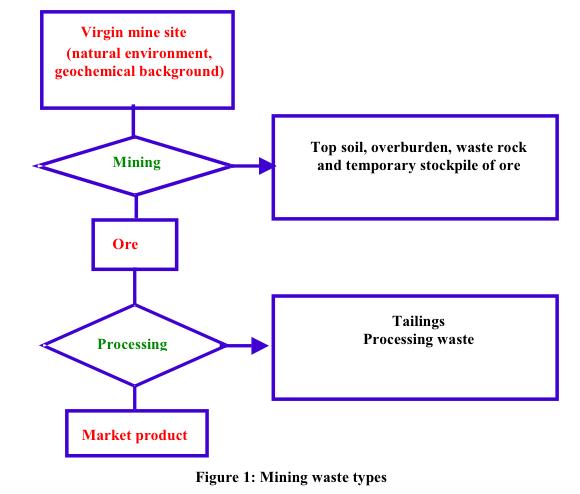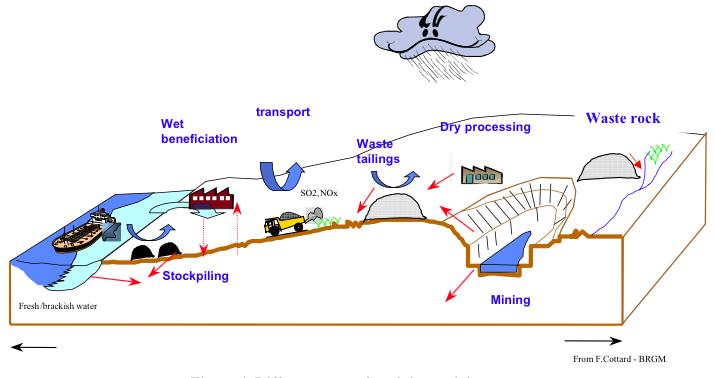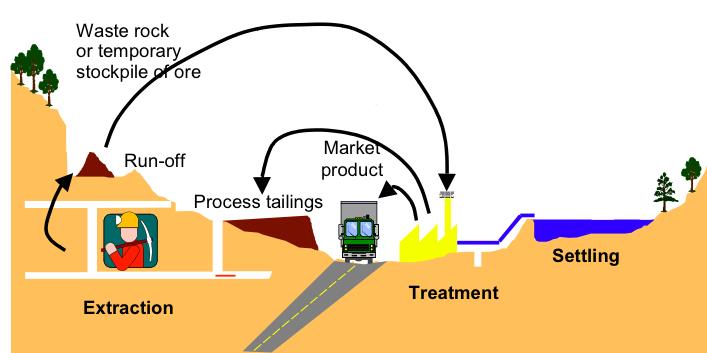Quarry closed and exhausted mine recovery laws and cases: The European Union and The Netherlands Framework
- Date2017-04-19 00:00
- View1,262
Quarry closed and exhausted mine recovery laws
and cases:
The European Union and The Netherlands
Framework
Introduction
Mine recovery has always been a contentious issue in different
countries. The various valuation put into mining and the resources and waste
have been analyzed by different economy ecologists looking at the valuation,
appropriation of mining waste and resources especially after a mining site has
been closed.
Further, mine
closure planning is relatively new to the mining industry and has evolved since
it was first developed as understanding and awareness of mining’s environmental
legacy increased, more stringent regulations were introduced, and mining
companies became financially liable for reclamation. Prior to the introduction
of mine closure requirements and best practices beginning in the 1970s, mines
were often abandoned without being adequately decommissioned or reclaimed by
today’s standards. Abandoned mines have the potential to be safety or
environmental hazards where infrastructure is left (buildings, open mine
shafts), contamination is not addressed, or acid
rock drainage is
being formed. Over the last forty years, environmental concerns over abandoned
mines and the cost to taxpayers for their cleanup have led governments to
tighten regulatory controls on mine closure. (Klade, 2000: 18)
Mine land
reclamation and closure plans are now required by regulatory agencies around
the world, and are often a component of the environmental impact assessment
process practiced in over 100 countries. Mine site rehabilitation has been
integrated into the early planning process, even preceding the start of mine
operations, and is now an ongoing consideration throughout the mine’s lifetime
both from a technical and a financial standpoint. (Ibid: 20)
Mine
closure plans are specific to each mine, and include details on how the mining
company will close the mine site, how environmental protection will be
achieved, and how the site will be returned to an acceptable state for a
pre-arranged land use. The terms reclamation, remediation, rehabilitation, and
restoration are all used to describe mine closure activities that attempt to
alter the biological and physical state of a site. The terms are sometimes used
interchangeably, and are closely linked, but refer to distinct steps in the
preparation of the site for another use.
Mining site closure in The
European Union and The Netherlands
The Netherlands has been a proponent of sustainable mine recovery
laws that also problematize how to reclaim waste and soil from recycled
building materials. Furthermore, it has also looked into the non hazardous
waste to elevate the safety by reclaiming deep holes and transforming it into
tourist sites.
However, because The Netherlands is part of the European Union, it
adheres to the European Union’s Framework on Management of Quarrying and
Ore-processing Waste” which lays out different scenarios on how to sustainably
recover mining site, waste and quarry closures.

Assessment of risks linked to mining waste
The notion of
environmental impact of mining activities is only fully meaningful if it
includes a change in the initial environmental parameters, due to such
activities. These parameters, which govern the "quality of the
environment", may have several components: chemical composition of the
waters, soils, etc.; biological diversity; visual aesthetic qualities, etc.
The major risks
linked to mining waste for the environment are twofold:
First, risks
associated with not only potential pollutant source (e.g. acidity and heavy
metals in non-ferrous metallic ore) but also the specific environmental context
and the presence of targets in the event of liberation. The possible risks from
the potential pollutant source (such as acidity and heavy metals) in waste is
dependent not only on the mineral characterisation of the solid but also on the
quality of the potential leachates, the direct environment (soil, groundwater,
surface water, air) and the potential targets (human, fauna and flora). The
realisation of a Geographic Information System (GIS) specific to mining waste
quantities and their pollution potential in different environmental contexts
would thus constitute a tool in the assessment of risks linked of such
materials (Rivas, V. and Cendrero, A.,
1996: 45). At the moment, such systems are used by some regional governments
for the information management on land planning. The risk management with a GIS
system in mining requires a considerable collection of specific data and
additional series of external analyses. This system should be well defined and
studied before to be developed. Then, results can be visualised successfully in
the GIS system.
Risks
associated with the stability of the tailings dam. With regards to the
potential risk from tailings dams, it will be necessary to evaluate on each
site the stability of tailings dam. Particular parameters such as exceptional
climatological conditions should be carefully taken into consideration during the
evaluation. In addition, common minimum safety standards for the design,
construction, operation and monitoring should be developed and applied. These
minimum safety standards could be built on the know-how of the profession. For
example, improvement of management of waste (Ibid: 56).
The
numerous regulatory texts, laws and standards, reveal that mines are a matter
of concern to the national administrations. Mining waste are governed by
general waste laws and texts. The extent, to which environmental concerns are
addressed in these national laws, varies from Member States to Member States
like The Netherlands. According to the commissioned report by the European Union, the amounts
and types of wastes as well as a short deion of the national legislation
of the various Member States vary.According to WWF (1999), a distinction can
be made between the following three types of mine and related generated waste:
-
Abandoned/old mines,
-
Operating mines based substantially on old operating methods,
-
Operating mines based on new design. For abandoned mines, it is
important:
-
to undertake site
monitoring (including land form(s), geology, soil type(s), hydrogeology, flora and
fauna, land use, heritage, overburden and waste characterisation, recycling
potential, etc.) to obtain a clear picture of the situation;
-
to establish treatment objectives according to required future land use
(for example, pollutant level in soil after treatment to be fixed depending on
the proposed land use). For operating mines based substantially on old
operating methods, it is essential to evaluate the control routine as regards
pollution risks and the stability of the tailings dams, and to take all
necessary measures to limit risks (for example, installing leachate collection
tanks, etc.). Substantial changes in the operation and monitoring phases are
likely to be necessary to ensure a sufficient level of environmental
protection. For
operating mines based on new design, it should be evaluated whether these
installations as well as their control routine are sufficient to prevent risks
of pollution or accident. Additional measures could be considered if necessary.
The
performance of old and new installations in terms of emissions and discharges
have to be evaluated in order to see if differences in methods have an impact. All management of mining waste
disposal facilities must take into consideration long term environmental
issues, because these structures will more than likely survive both the mine
and the mining company. This raises a legal problem as regards the
responsibility for maintenance and repair of these facilities since liability,
under most laws, cannot be endless. Even where the facility becomes a permanent
structure, it is still necessary to fit the site with a permanent analytical
and inspection system. Closure and after care operations are therefore of
paramount importance to lower, as far as possible, the long term environmental
risks. Research
and development programs should continue around sets of themes specific to the
various methods of mining-waste management.
Figure 2: Different steps of a
mining activity

European Union’s directive
According
to Euromines, the EU has reckoned that decisions and future research and
development must be based on current knowledge (for example results from
foreign countries) but detailed further knowledge should be developed on:
·
the reactivity of specific mining waste; this could be approached in
different ways such as leaching tests, long-term column tests and normalised
tests as being developed in the context of the Landfill Directive. Even if
there are no international standard, there exist a number of normalised test
protocols for static and kinetic tests of acid drainage potential, which is a
key characteristic with regards to waste originating from sulphidic minerals,
·
the behaviour of metallic molecules (originating from mining waste) in
the subjacent geologic layers and prediction of their fate using tools such as
geochemical and solute-transport modelling, Their behaviour within the waste
deposit is also important (adsorption and other attenuation processes),
·
the discrimination between geochemical background and mine-impacted
soils and waters,
·
the long term stability of dams,
·
the improvement of recycling practice related to the characteristics of
mining waste,
·
the potential risks raised by certain covering techniques of tailing
ponds (e.g. water cover),
·
the process management and protection measures during operation and
their subsequent impact on the closure phase. This report presents the
methodology employed, the obtained results and the current status of mining
waste in the European Union. The above-mentioned considerations support the
initiatives launched by the European Commission to set up an appropriate
Community framework to ensure the safe and environmentally sound disposal of
mining waste. Needs for coordination, information and specific actions on hot
spot are necessary.
Figure 3: Different Types of Mining Activity Waste

On the domestic front: The
Netherlands
The Netherlands has mandated the EWSR to lay
down regulations governing shipments of waste products which cross borders.
Depending on type of waste product, the intended use and the countries of
dispatch and destination (and possibly transit), there are three possibilities:
1.
The transport of the waste materials is allowed,
provided that the proper form with accompanying information is present
(appendix VII document). This is also on the condition that a EWSR contract is
concluded between the commissioning party of the transport and the consignee of
the waste products.
2.
The transfer is allowed only if all the
countries concerned have given prior consent. To obtain thisconsent, there must
be a notification submitted prior to transport.
3.
The transfer is prohibited.
4.
The rules for non-hazardous waste products
(green list for waste are, in principle, less stringent than for hazardous
waste products (orange list for waste = appendix IV EWSR).
5.
Non-hazardous waste products intended for useful
application can generally be transferred with accompanying information. At the
request of country destination, stricter regulations are nonetheless applied
for non-hazardous waste products in certain cases. This is particularly the
case with the export of waste products to non-OECD countries.
6.
Shipment of hazardous waste products and of
non-hazardous waste products that are intended for disposal shall be subject to
stricter rules. Within Europe, there must be prior permission obtained from all
the countries concerned by means of a notification procedure (see point 2
above). The export out of the European Union of waste products intende for
disposal is even completely banned.
7.
The export ouf of the European Union of
hazardous waste destined for recovery to non-OECD countries is also prohibited
in all cases.
The EWSR has also set out what needs to be present in the
transport of waste products:
If waste is transported over Dutch territory, then the carries must
have been recognized by the Dutch Government via inclusion on the national list
of companies that are allowed to carry, collect, trade or mediate in waste
products, the so-called VIHB list of the NIWO Foundation (National and
International Road Transport Organization). You should be able to submit this
VIHB-statement(Rivas, V. and Cendrero, A., 1996: 64).
Subsequently, the supervisory authorities for the enforcement of the
EWSR in the Netherlands is the Human Environment and Transport Inspectorate
(ILT). The inspections are carried out in collaboration with the police,
customs, NVWA, Royal Netherlands Military.
In conclusion, the European Union has set out and standardized the
terms on how to close mining and quarry sites in the territories of the member
states of the EU. However, the policy sought to consider the variegated
experiences, topography, and adaptability of the various member states under
the EU. At the national level, The Netherlands has a streamlined approach on
how to conduct closure of mining and quarry sites.
References:
Euromines
(1998-1999), Metals and Minerals Mining, Annual report (1998-1999)
Klade
M. (2000). Survey and assessment concerning the environmental impact of waste
materials produced in the exploration, extraction and processing of mineral
resources, Thesis, Institute fur Bergbaukunde, Bergtechnik und Bergwirtschaft.
Rivas
V. & Cendrero A (1996). Assessment of the Effects of Mining and
urbanisation on Earth Surface Process in The Netherlands. Universidad de
Cantabria, Santander.
WWF
(1999), Toxic waste storage sites in EU countries, A preliminary risk
inventory, IVM Report number R 99/04.
* Introduced here is an article written by one of KEI's environment correspondents. KEI invites students studying abroad and researchers working for foreign research institutes to send articles on various global environmental issues.
- PrevThe Industrial Emissions Directive (IED), The European Union, and The Netherlands
- NextConserving the soil on new recycled landfill mining in The Netherlands
